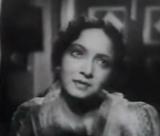
Mumtaz Shanti
Encyclopedia

Bollywood
Bollywood is the informal term popularly used for the Hindi-language film industry based in Mumbai , Maharashtra, India. The term is often incorrectly used to refer to the whole of Indian cinema; it is only a part of the total Indian film industry, which includes other production centers producing...
yesteryears, she was very popular in the 40's and early 50's with hit movies like Basant
Basant (1942 film)
Basant is a 1942 Indian film. Music for the film was composed by Indian flute maestro and music director Pannalal Ghosh. With the heroine Mumtaz Shanti and hero Ulhas and Madhubala as a child artist....
(1942), Kismet
Kismet (1943 film)
Kismet is a 1943 Indian Hindi film, written and directed by Gyan Mukherjee and produced by Bombay Talkies during the second world war period, while it was in a succession battle between Devika Rani and Sashadhar Mukherjee after owner Himanshu Rai's death...
(1943), Ghar Ki Izzat
Ghar Ki Izzat (1948 film)
Ghar Ki Izzat is an old classic with leads Dilip Kumar and Mumtaz Shanti. Other artists are Manorama, Jeevan and Gope. Music by Pundit Gobindram. The film is directed by Ram Daryani....
(1948) with young Dilip Kumar
Dilip Kumar
Dilip Kumar , is an Indian actor and a former Member of Parliament.He lives in Pali Hill, Bandra in Mumbai, India. He is commonly known as "Tragedy King",and is described as "the ultimate method actor" by Satyajit Ray....
The Movie Kismet in 1943 was the most significant year of her illustrious career. The film starring Ashok Kumar as the hero, broke all previous box office records and, besides celebrating many jubilees all over India, ran for 3 years in a single theatre in Calcutta — a record that has been broken only by Ramesh Sippy’s Sholay
Sholay
Sholay is a 1975 Indian action-adventure film produced by G.P. Sippy and directed by his son Ramesh Sippy. It is considered among the greatest films in the history of Indian cinema. Released on 15 August 1975, it stars Dharmendra, Amitabh Bachchan, Hema Malini, Sanjeev Kumar, Jaya Bhaduri and...
in the seventies and later by Dilwale Dulhaniya Le Jayenge. Almost all the songs: (Dheerey Dheerey Aa Re Baadal / Ashok Kumar and Ameer Bai, Papiha Re / Parul Ghosh, Aaj Himalay Ki Choti Se / Amir Bai and Chorus, Ab Tere Siwa Kaun Mera / Ameer Bai, Ghar Ghar Mein Diwali Hai / Ameer Bai) became a rage throughout the country.
Mumtaz Shanti died unknown and unsung in Pakistan in about 1993 / 1994. The woman celebrated for her sensational dancing and
considerable acting talent who once guaranteed the success of any movie that she was associated with, died without any notice having been taken of her death by those among whom she lived, in what can only be called dignified poverty.
Mumtaz Shanti was a very popular movie star in the 40′s and her film Kismet (1943) is regarded as one of the biggest hits of Hindi cinema. Mumtaz started her career in the early thirties in Lahore, by working in a local theatre. She got a break in Lahore’s Mangti and was lured to Bombay. With the success of Basant (1942) and Kismet (1943) (in which she played a lame girl opposite Ashok Kumar) Mumtaz Shanti became one of the top actresses of Bombay Talkies. She also played the female lead in Ghar ki Izzat (1948) as the suffering wife of Dilip Kumar. In the mid-fifties, she migrated to Pakistan along with her famous writer-director husband Wali-Saheb. Wali started his career as a writer in the early thirties in Lahore. Wali used to write songs and stories for others before getting his first assignment as a director. Of the few films he directed in Bombay including Dekho-ji, Heer Ranjha and Putli, only the last caught the public’s attention. In Pakistan, while Mumtaz Shanti retired to become a housewife, Wali made Guddi Gudda in 1956 and later Lukan Mutti and Sohni Kumaran, but none clicked at the box-office. He died of heart failure in 1977. His son Zafar Iqbal is a noted maker of documentaries, who worked as a producer in the Ministry of Information and Broadcasting, Government of Pakistan.
Mumtaz Shanti died unknown and unsung in Pakistan around 1993/1994.
Filmography
- Aakraman (1975)
- Zamane Ki Hawa (1952)
- Aahuti (1950)
- Biwi (1950)
- Putli (1950)
- Ghar Ki Izzat (1948)
- Heer Ranjha (1948)
- Padmini (1948)
- Diwani (1947)
- Doosri Shadi (1947)
- Dharti (1946)
- Magadhraj (1946)
- Pujari (1946)
- Shravan Kumar (1946)
- Chand Chakori (1945)
- Bhartruhari (1944)
- Lady Doctor (1944)
- Pagli Duniya (1944)
- Badalti Duniya (1943)
- Kismet (1943)
- Sawaal (1943)
- Basant (1942)

